Month:
July, 2006
Laurel Hill Cemetery, Philadelphia
Notice: Use of undefined constant the_post_thumbnail - assumed 'the_post_thumbnail' in /home/netscrib/public_html/civilwarcavalry/wp-content/themes/wittenberg/archive.php on line 65

As I said on Monday night, Philadelphia’s Laurel Hill Cemetery is a classic example of Victorian cemetery in the French mode. I took a fair number of photographs while I was there, and I want to share some of them with you.
One note of explanation is required. It was 102 degrees with 90% humidity that day, and it was just beastly hot. Within seconds of getting out of the car, I was drenched with sweat, and it was just too hot to do the sort of walking around and searching that I would normally do. Consequently, there were a couple of graves that I had hoped to visit (and photograph) but couldn’t find because it was too damned hot and also because I ran out of time–I had a nearly ninety mile drive to make before my talk that night. Two of the graves I’d hoped to visit but missed were John C. Pemberton, the Philadelphia resident who commanded (and surrendered) the Confederate army at Vicksburg, and Col. Richard Rush, the original commander of the 6th Pennsylvania Cavalry, also known as Rush’s Lancers. While wandering around searching for the Dahlgren graves, I did find the grave of the parents of Maj. Gen. George B. McClellan, and shot a photo of them for Dimitri Rotov.
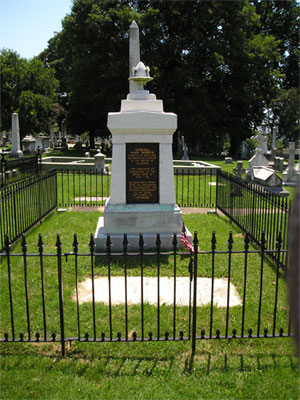
This is the grave of Revolutionary War hero Maj. Gen. Hugh Mercer, who was killed in action at Princeton, January 2, 1777.
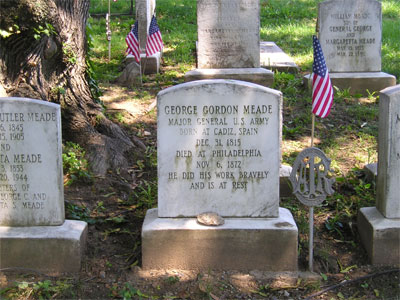
This is the grave of Maj. Gen. George Gordon Meade, who commanded the Army of the Potomac from June 28, 1863 until the end of the Civil War.
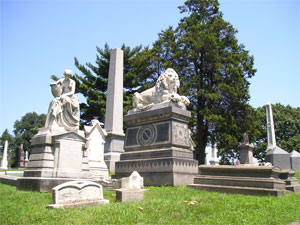
The impressive marker with the lion is that of Maj. Gen. Robert Patterson, who ineffectively campaigned against Stonewall Jackson in the Shenandoah Valley in 1861.
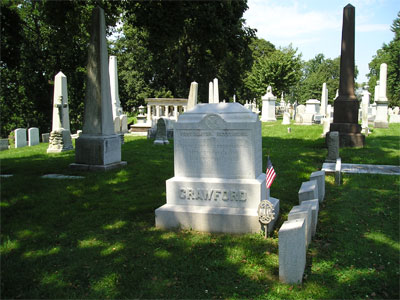
This is the grave of Bvt. Maj. Gen. Samuel W. Crawford, who went from garrison doctor at Fort Sumter to effective division commander in the Fifth Corps.
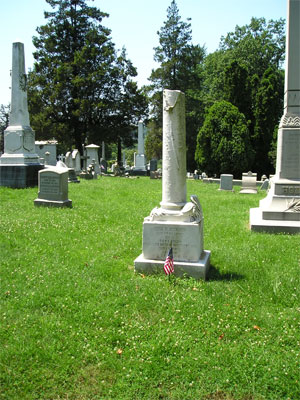
This is the grave of Lt. Benjamin “Benny” Hodgson, who was killed during the valley fight at the Battle of the Little Big Horn, June 25, 1876. The word “cavalry” is misspelled on the marker as “calvery”.
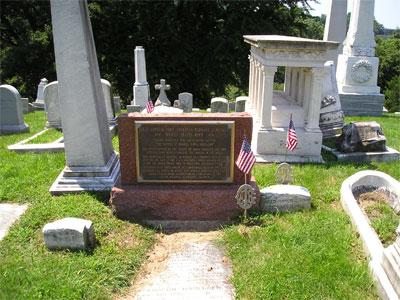
These are the graves of Rear Admiral John A. Dahlgren (on the left, with the very large marker) and his son, Col. Ulric Dahlgren (the small marker on the right).
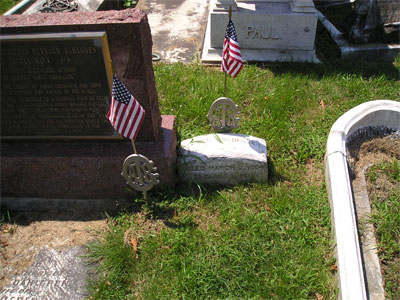
There is also a detail of Ulric’s marker.
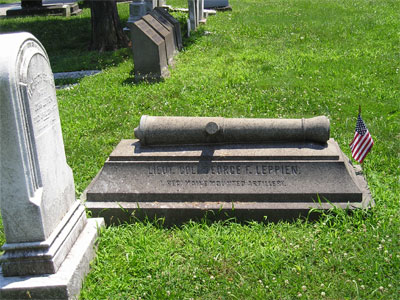
This is the grave of Col. George Leppien, the Pennsylvania artillerist who was killed in action in 1864. Note the rendition of a Napoleon gun on the grave.
I wish I’d had more time and it wasn’t so beastly hot.
Scridb filterInteresting Things Happen When I Travel
Notice: Use of undefined constant the_post_thumbnail - assumed 'the_post_thumbnail' in /home/netscrib/public_html/civilwarcavalry/wp-content/themes/wittenberg/archive.php on line 65

I’m writing this from a Fairfield Inn in Dover, Delaware. I’m here because I spoke to the Central Delaware Civil War Roundtable tonight. It was quite an interesting evening.
A couple of weeks ago, I was asked for a photo, as the CWRT apparently placed something in the local newspaper, which ran the photo with the piece. One of my high school classmates–whom I haven’t seen in nearly twenty years, but who lives and works here, spotted it. She had another obligation tonight and couldn’t come hear me talk, but she wrote me a nice note and left it at the meeting place for me. I was taken aback when I was told that there was a note for me there, and it really kind of blew me away that she took the time to do that. What a pleasant surprise!
Then, after my talk, I got an even bigger surprise. One of the members of the group came up to me after the talk and asked whether I would recognize the name if he told me that his great-great grandparents had been married by S. L. Gracey. That got my attention. Samuel L. Gracey was the regimental chaplain of the 6th Pennsylvania Cavalry, and he wrote the 1868 regimental history of the unit.
The fellow’s ancestor was a member of Co. A of the Lancers, and was married by Chaplain Gracey after the war. The fellow then pulled out a photo. It was a photo of the annual reunion of the veterans of the regiment–usually conducted at Gettysburg–from September 29, 1912, taken in front of the rocks at Devil’s Den. There were only a couple of dozen of them left 49 years after the battle, and it was really a spectactular photograph. He shared his ancestor’s story with me, and then really blew me away–he offered to scan the reunion photo and gave me permission to include it in the new regimental history.
Needless to say, that made my night.
It never ceases to amaze me when I think of the generosity of the people that I’ve met over the years in doing this work. So many neat things have been given to me by folks and this is yet another example of that. I understand why the academics among us resist the idea of speaking to CWRT’s for free, but finds like this make it worthwhile for me. I’m so glad I came here, even if it does mean getting up at 5:15 tomorrow morning to make my flight home…. 🙂
Scridb filterVictorian Cemeteries
Notice: Use of undefined constant the_post_thumbnail - assumed 'the_post_thumbnail' in /home/netscrib/public_html/civilwarcavalry/wp-content/themes/wittenberg/archive.php on line 65

I visited Ully Dahlgren’s grave in Philadelphia’s Laurel Hill Cemetery today. I was struck by just how small the marker on his grave is, particularly as compared to the huge marker for his father that’s quite literally next to Ully’s grave.
Laurel Hill was THE cemetery for Victorian-era Philadelphians. It was designed to be like a park, overlooking the Schuylkill River, and is very different from modern cemeteries. Although it was 100+ degrees out while I was at Laurel Hill, I still did a little bit of wandering around and shot photos of some of the graves of some of the famous folks buried there, but I got to only a small portion of them. It was too hot, I had too little time, and I also was having difficulty finding graves. Tomorrow, once I’ve had a chance to download the digital camera, I will post a few of the notable graves here.
Laurel Hill is one of several cemeteries of its ilk I have visited. I’ve spent time in the city cemetery in Lexington, KY, and in Spring Hill Cemetery in Cincinnati, which is even more park-like than Laurel Hill. There’s also Charles Evans Cemetery in my home town of Reading, PA, which is the final resting place for several Civil War generals, including Bvt. Maj. Gen. David M. Gregg, Brig. Gen. Daniel Keim, and Brig. Gen. Alexander Schimmelfennig, who lies under a nifty marker that’s topped by a marble pickelhaube, and which is marked in German. Hollywood Cemetery in Richmond is another of this variety, but I have yet to visit Hollywood (that, however, will change next week).
These cemeteries are pretty remarkable places. Unlike the memorial park near my house, which is not conducive to folks visiting, these cemeteries were designed to be treated like parks. In fact, Victorians thought nothing of having picnics and outings there. It was sort of like having a picnic in the park, only with lots of dead folks there. To our modern mentality, it seems kind of creepy, and I can certainly understand that. However, Victorians had a different take on death, and they really didn’t give it a second thought.
The other thing that strikes me when I visit these cemeteries is the complexity and beauty of the monuments. There are so many tall obelisks in Laurel Hill that it seems like needles reaching for the sky at times. There are also some amazing examples of sculpture atop some of the graves–I saw one today that was a bronze sculpture of the occupant of the graves seated in a chair, obviously lost in deep thought. The cost of such monuments today would be so astronomical as to be completely offputting. The Victorians, however, thought absolutely nothing of it, which is why you see some of the remarkable structures you see in these Victorian cemeteries.
I also was amazed at the number of fancy mausoleums that fill the center part of Laurel Hill. Some of these structures are incredibly ornate–my wife calls them high rise condos of death, and it’s really not that far from being an accurate description.
As I said, I hope to post some photos of some of the notable graves tomorrow night. Stay tuned.
Scridb filterGood News From Trevilian Station
Notice: Use of undefined constant the_post_thumbnail - assumed 'the_post_thumbnail' in /home/netscrib/public_html/civilwarcavalry/wp-content/themes/wittenberg/archive.php on line 65

A couple of weeks, I shared some good preservation news from Trevilian Station that a proposal to erect a cellular telephone tower over a critical portion of the battlefield had been rejected by the local board responsible for such things.
Today, I have even better preservation news from Trevilian Station.
The Trevilian Station Battlefield Foundation is a grass-roots organization that started with some local folks who live in Louisa County. When they first started out almost ten years ago, they knew next to nothing about how to preserve battlefield land, and they certainly hadn’t saved an inch. Over time, they’ve learned and have bcome one of the most effective preservation groups around.
The battlefield itself ranges over almost 7,000 acres of Louisa County, Virginia. The first day of fighting covered a lot of ground, as the Confederate cavalry fought a fierce delaying action along the Fredericksburg Stage Road. Virtually ever inch of that road was fought over, and most of it was very hard fighting. The bulk of the first day’s battlefield is, therefore, along this road.
In 2001, with the assistance of the Civil War Preservation Trust, the TSBF preserved about 1,000 acres of the core of the first day’s battlefield, land adjacent to the Fredericksburg Stage Road (Rt. 613). Another parcel of land, the 428 acre Dunn Farm, has been acquired by the TSBF, again with the assistance of the CWPT and an entity called Bernstein Louisa Properties, LLC (I am not familiar with this entity and don’t know what its mission is, but I appreciate its assistance).
The Dunn Farm was an important site of the first day of the battle, and was near the site where Wade Hampton personally led a saber charge by the Citadel Cadet Rangers, a company of the 4th South Carolina Cavalry. As Jerry Harlow of the TSBF has put it, just a few years ago, the Dunn Farm would have been an impossible dream. Today, the TSBF owns it, and it is forever preserved.
The acquisition of the Dunn Farm means that the TSBF now owns exactly 2,000 acres of core battlefield land. Not bad for a grass roots organization.
Congratulations on a job very well done, guys. And keep up the very good work.
Scridb filterBroadfoot O. R. Supplements
Notice: Use of undefined constant the_post_thumbnail - assumed 'the_post_thumbnail' in /home/netscrib/public_html/civilwarcavalry/wp-content/themes/wittenberg/archive.php on line 65

As anyone who has spent any significant time working with the Official Records of the Civil War (the “O. R.”) knows, there was a ton of information–an overwhelming amount, actually–included in them. There was also a lot of information that was not included.
Tom Broadfoot, the owner of Broadfoot Publishing, decided to publish a 100-volume supplement to the O. R. that would add additional reports, a couple of transcripts of court martials or courts of inquiry, and complete itineraries of every regiment of either side. This evening, I went through several volumes of the Broadfoot supplements to make sure I hadn’t missed anything Dahlgren-related, which got me thinking about the set, which is what inspired this post.
There are two major problems with the Broadfoot supplements. First, and foremost, is the price. The $5500 price is enough to make anyone gag; only libraries with too much money have the ability to afford this set. It’s not available on CD-ROM, so if you want it, you’ve either got to bite the bullet and spend the money, or you have to find a library and use it there.
That, of course, raises the question of whether they’re worth the outrageous price. My humble opinion is that they are not. I have a small portion of the set–the twelve volumes that truly supplement the O. R. and the two trial transcripts. I also have four or five of the itinerary volumes. When I got the first volume of the itinerary stuff, I was definitely not impressed, but I decided to wait, get a couple or three more of those volumes, and then make a decision. I decided that they were definitely NOT worth the money and terminated my subscription at that point. I have those volumes of the Broadfoot supplement that are worth owning.
There’s also the issue of what’s in the volumes of supplemental material. Some of it is quite good. Much of it is not. The sense that I get is that Broadfoot was hasty about trying to get the set published instead of investing more time and effort into researching and gathering additional material, as I am aware of some good material that was uncovered after these volumes were published but which would have been appropriate to include. As just one example, I recently found a report of the actions of the 1st Vermont Cavalry during the Gettysburg Campaign written by the regimental commander to the Vermont adjutant general that was not included in the O. R. but which was published in a local newspaper in Rutland, VT. This report is different from the one in the O. R., and includes some different/additional details on the specifics of Farnsworth’s Charge on the third day at Gettysburg. It’s just one of many such examples that I am aware of.
My conclusion, therefore, is that the set might have been worth its absolutely outrageous purchase price if the additional time and effort to do it right had been invested by the publisher. As it stands, it’s one of those “what might have been” things that remains a persistent disappointment to me.
Scridb filterCovering Force Actions vs. Defenses in Depth
Notice: Use of undefined constant the_post_thumbnail - assumed 'the_post_thumbnail' in /home/netscrib/public_html/civilwarcavalry/wp-content/themes/wittenberg/archive.php on line 65

Last night, I promised that I would address the difference between a covering force action and a defense in depth, and why I am now persuaded that the tactic used by John Buford at Gettysburg was actually a covering force action and not a defense in depth. Here goes…..
I find it easier to use modern military definitions to define these terms. Even though they use modern parlance and anticipate modern weaponry, they still apply equally well to Civil War tactics.
The Pentagon defines a defense in depth as this: “The siting of mutually supporting defense positions designed to absorb and progressively weaken attack, prevent initial observations of the whole position by the enemy, and to allow the commander to maneuver the reserve.”
In other words, a defense in depth requires that a defender deploy his resources, such as fortifications, field works and military units, both at and well behind the front line, falling back from one defensive position to another, with the whole idea being to suck the enemy in so that he exposes his flanks to attack. The strategy is especially effective against an attacker who is able to concentrate his forces to attack a small number of places along an extended defensive line. It employs the deployment of force in mutually supportive positions. In other words, the idea is to force the enemy to drive the defender from each chosen position and inflict casualties upon him in the process.
A recent U. S. Army manual defines a covering force action thusly: “The covering force operates independently from the main body. The purpose of covering force operations is to develop the situation early and deceive, disorganize, and destroy enemy forcing. However, unlike screening and guard forces, a covering force is tactically self-contained and often seeks to become decisively engaged with the enemy. Cover operations are performed in the offense or defense and can be conducted by either the ACR or separate brigade.
There is no clear line between the covering force battle and the main battle. Covering forces continue to operate in some areas, while the main battle is pursued in others. Throughout the operation, battles shift from defensive action in one locale to offensive action. That is why the ACR or separate brigade conducting a covering force mission must be prepared for either mission.
When a covering force action begins, the main body generally is not engaged. Depending on how much warning it gets, and the mission of the main body, the covering force can be heavily augmented with engineers, MI, and artillery before the battle begins. With less warning, support arrives with the battle already underway. In any event, the covering force is expected to continue resistance until the corps has had time to deploy. Because it operates independently from the corps main body, the MI company must be able to move all of its personnel, systems, and equipment with its own organic assets.”
In other words, the idea behind a covering force action is to trade time for space, thereby allowing a detached forward unit (usually cavalry) to delay the advance of the enemy long enough to permit the main body to come up and engage. The covering force will operate independently of the main body.
Two examples of defenses in depth come to mind. General Daniel Morgan designed and implemented an excellent defense in depth that was used to great effect at the Battle of Cowpens. This tactic, which used militia to draw in Tarleton’s men, then exposed them to a galling fire from the main line and then to a cavalry charge into the flank. Nathanael Greene used the same tactic effectively at Guilford Court House, although Greene was eventually defeated.
In the Civil War, Lt. Gen. William J. Hardee designed a defense in depth very similar to–some say inspired by–Morgan’s defense in depth at Cowpens that he used effectively at the Battle of Averasboro on March 16, 1865. Hardee, with less than 10,000 men, was able to hold off half of Sherman’s army for an entire day by using a well-designed defense in depth. He used three prepared defensive positions to do so, falling back from each one as he was driven from them, until he ultimately reached the third, and final, line. By that time, it was dark, and Sherman didn’t have the stomach to attack that line. Hardee then pulled out during the night.
What John Buford designed and implemented at Gettysburg was a classic example of a covering force action, one that was, in fact, such a perfect textbook example of one that it’s taught as a staff ride by the Army to this day. The whole idea was to trade three ridge lines worth of space for time to permit Reynolds and First Corps to come up and engage. Buford’s tactic delayed the Confederate advance for nearly five hours on the first day of the Battle of Gettysburg.
Having studied all of this in much greater depth, I came to the conclusion that my prior assertions about Buford using a defense in depth was just plain wrong, and I’ve said as much publicly many times. It was, indeed, a perfectly designed and perfectly executed covering force action.
Scridb filterAbout New Blogs and Some Existing Ones
Notice: Use of undefined constant the_post_thumbnail - assumed 'the_post_thumbnail' in /home/netscrib/public_html/civilwarcavalry/wp-content/themes/wittenberg/archive.php on line 65

I’ve been thinking about some of the feedback that I’ve received on Adam Hendel’s blog. I have to admit that I agree with the folks that noted that there are some flaws with the articles posted on Adam’s blog. Adam found a VERY old writing of mine that described John Buford’s defense at Gettysburg as a defense in depth. Once upon a time, I believed that to be the case, but after a great deal of additional study, I came to the conclusion that his tactic was, in fact, a covering force action. I’ll get into the difference between the two in tomorrow’s post here. Suffice it to say that I have publicly corrected myself numerous times and in numerous forums over the years, and he failed to pick that up. So, I sent him a comment about it. The comment was eventually posted, but it took three days. I have issues with that, as I don’t want the public thinking that something I said years ago, but which I have publicly repudiated is still my view of things.
In the past, I have simply pointed out the presence of a new blog, given a comment or two about the content, and just added it to the list of blogs linked to this one. After reading the criticisms of Adam’s blog and my own issues with it, I have decided to change my policy. From now on, I will wait a bit to put my seal of approval on them. I want to be sure that they’re worthy of bringing to the attention of my readers. I will probably remove the link to Adam’s blog in the next couple of days.
There are also a couple of bloggers who simply don’t post. One blog hasn’t had a new post since June 16, and another has had only two since June 1, one of which had nothing at all to do with history. Whether the bloggers’ jobs get in the way, or they don’t have anything to say, it’s hard for me to endorse blogs where nothing new is posted for more than a month at a time. If that remains the case, I will probably remove those links. So, please don’t be surprised if some of the links disappear, probably sooner than later.
Scridb filterA VERY Pleasant Surprise
Notice: Use of undefined constant the_post_thumbnail - assumed 'the_post_thumbnail' in /home/netscrib/public_html/civilwarcavalry/wp-content/themes/wittenberg/archive.php on line 65

Susan’s sister from Pittsburgh came into town today to see an old friend who’s about to move to Arkansas. She brought the twins with her, and we all went out to dinner tonight. After dinner, the four women decided that they wanted to go shoe shopping.
That was an activity that was about as appealing to me as getting my teeth drilled without novocaine, so I took my leave and wandered over to the local Barnes & Noble store. Now, this is the one that I swore rather vehemently I wouldn’t go into since they won’t carry my books. It’s a matter of principle with me, but I went tonight because there wasn’t much else to do to pass the time. It was the better of two bad options.
Having said that, I was very pleasantly surprised when I got there. If anything, this store’s selection of Civil War books is even smaller now than it was the last time that I was in it. They had maybe 25 Civil War books in the history section, and I was stunned to find four copies of my Monroe’s Crossroads book there among the 25 or so Civil War books. I was so stunned that I had to call Susan and tell her.
I gathered up the four copies, took them to the counter, and asked if they would like me to sign them for them. The guy behind the counter looked at me like I was brain damaged, so I told him that yes, I am the author of the book, and yes, I live in Columbus, and that I would be very pleased to sign the books if they wanted me to do so. He blinked stupidly a couple of times, and then what I was telling him finally sunk in. At that, he grabbed a Sharpie and asked me if I would mind signing all four. I said sure, and did so. I prefer a fountain pen with a medium nib when signing, but on this occasion, I would have signed with anything. I gave him a business card and told him to call me if he needed any more signed.
I was so tickled by finding my book there that I actually spent some money in the store. I bought a dirt-cheap ($5) copy of the Mary Chesnut diary (hard to believe, I know, but I never owned a copy of it before tonight) and a magazine, spending, all told, about $9.00. Considering that it’s been over a year since I last spent anything in there, that was pretty remarkable.
I MAY actually go back there again some time soon. As long as they continue to carry my books, I will gladly go back. The minute my books disappear again, so do I.
It’s my own little futile gesture. I realize it’s meaningless in the big scheme of things, but it makes me feel better. Ultimately, that’s what really matters here.
Scridb filterYet Another New Civil War Blog
Notice: Use of undefined constant the_post_thumbnail - assumed 'the_post_thumbnail' in /home/netscrib/public_html/civilwarcavalry/wp-content/themes/wittenberg/archive.php on line 65

Adam Hendel also has a new Civil War blog, The American Civil War, which so far consists of some interesting scholarly articles. Have a look. Welcome to the blogosphere, Adam. I’ve added a link to your blog.
Scridb filterWings Over Pittsburgh
Notice: Use of undefined constant the_post_thumbnail - assumed 'the_post_thumbnail' in /home/netscrib/public_html/civilwarcavalry/wp-content/themes/wittenberg/archive.php on line 65

Sorry I’ve been quiet. We went to Pittsburgh this weekend to visit Susan’s sister. My nieces have been bugging us to come visit, so we pulled the trigger this weekend and went.
On Saturday, we went to the Wings Over Pittsburgh air show, held on the grounds of the Air National Guard base that’s adjacent to Pittsburgh International Airport. It was a very impressive show. It’s too bad that my nieces, who are 11 1/2 (they’re identical twins) couldn’t possibly have been less interested, because there was some incredibly cool stuff there. My nephew, who’s six, was big into it, and he had a ball.
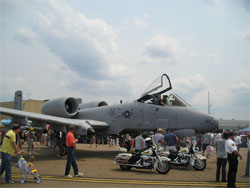 We had lunch when we first got there. We ended up sitting on the ground under the right engine of an A-10 Warthog. There’s something very surrealistic about that. The kids, of course, were completely oblivious to what those aircraft do and what they were designed for, which made it all the more surrealistic. Susan’s sister had oil from the engine drip on her, so the memory of that was the dripping oil and not the aircraft itself.
We had lunch when we first got there. We ended up sitting on the ground under the right engine of an A-10 Warthog. There’s something very surrealistic about that. The kids, of course, were completely oblivious to what those aircraft do and what they were designed for, which made it all the more surrealistic. Susan’s sister had oil from the engine drip on her, so the memory of that was the dripping oil and not the aircraft itself.
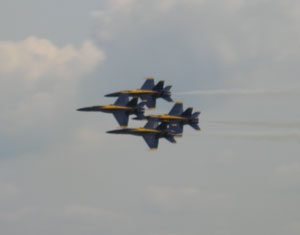 There was a very impressive demonstration by the Blue Angels, as well as a bunch of other interesting aerobatics. When I was a child, there was a world-class air show in my hometown of Reading, Pennsylvania. They would alternate years–one year would be the Blue Angels, and the next year would be the Air Force Thunderbirds. Then, when I was in high school, they went to an every-other-year format, and I haven’t been there in years. However, I saw the Blue Angels regularly. Too bad it’s been years since the last time.
There was a very impressive demonstration by the Blue Angels, as well as a bunch of other interesting aerobatics. When I was a child, there was a world-class air show in my hometown of Reading, Pennsylvania. They would alternate years–one year would be the Blue Angels, and the next year would be the Air Force Thunderbirds. Then, when I was in high school, they went to an every-other-year format, and I haven’t been there in years. However, I saw the Blue Angels regularly. Too bad it’s been years since the last time.
Now, they fly F-18 Hornets, and they put those planes through their paces. The precision is genuinely remarkable; some of the maneuvers of the four-plane diamond were less then two feet apart in places. It was damned impressive. They went supersonic a couple of times, meaning that some very memorable sonic booms left a lot of people covering their ears. Even the flight crews of the other aircraft were watching the maneuvers of the Blue Angels raptly and intently. I spotted the crew of one of the cargo planes watching from on top of their plane, which was a neat thing to see.

A C-5 Galaxy also performed some maneuvers. If you’ve never seen one of those flying giants in the air, it’s remarkably nimble given its incredible size and bulk.
Among the other aircraft on display:
A-10 (I just love the Warthog–they’ve got a face only a mother can love, but what an amazing aircraft)
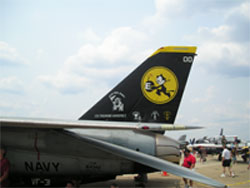
F-14 (there’s only one squadron of them left on active duty, and that will be retired in September)
F-15
F-16

B-52 (the BUFF is still a remarkable aircraft; it’s hard to believe that they’re 50+ years old and still a workhorse)
KC-135
C-17 (I’d never seen one up close previously)
C-141
CE-130
B-24
B-25
All things considered, it was really a remarkable visit, and one I’m very happy we made. Sadly, my nieces got all crabby and very unpleasant and pretty much insisted that we leave early, so I missed part of the Blue Angels’ show, which was disappointing indeed.
I know that this has nothing to do with the Civil War, but I’ve always believed that today’s version of the horse cavalryman is either the tanker or the fighter pilot, or, perhaps, both.
Scridb filterNotice: Undefined index: id in /home/netscrib/public_html/civilwarcavalry/wp-content/themes/wittenberg/footer.php on line 8
Notice: Undefined index: id in /home/netscrib/public_html/civilwarcavalry/wp-content/themes/wittenberg/footer.php on line 8
Notice: Undefined index: std in /home/netscrib/public_html/civilwarcavalry/wp-content/themes/wittenberg/footer.php on line 8
Notice: Undefined index: id in /home/netscrib/public_html/civilwarcavalry/wp-content/themes/wittenberg/footer.php on line 8
Notice: Undefined index: id in /home/netscrib/public_html/civilwarcavalry/wp-content/themes/wittenberg/footer.php on line 8
Notice: Undefined index: std in /home/netscrib/public_html/civilwarcavalry/wp-content/themes/wittenberg/footer.php on line 8
Notice: Undefined index: id in /home/netscrib/public_html/civilwarcavalry/wp-content/themes/wittenberg/footer.php on line 8
Notice: Undefined index: id in /home/netscrib/public_html/civilwarcavalry/wp-content/themes/wittenberg/footer.php on line 8
Notice: Undefined index: std in /home/netscrib/public_html/civilwarcavalry/wp-content/themes/wittenberg/footer.php on line 8
Notice: Undefined index: id in /home/netscrib/public_html/civilwarcavalry/wp-content/themes/wittenberg/footer.php on line 8
Notice: Undefined index: id in /home/netscrib/public_html/civilwarcavalry/wp-content/themes/wittenberg/footer.php on line 8
Notice: Undefined index: std in /home/netscrib/public_html/civilwarcavalry/wp-content/themes/wittenberg/footer.php on line 8
Notice: Undefined index: id in /home/netscrib/public_html/civilwarcavalry/wp-content/themes/wittenberg/footer.php on line 8
Notice: Undefined index: id in /home/netscrib/public_html/civilwarcavalry/wp-content/themes/wittenberg/footer.php on line 8
Notice: Undefined index: std in /home/netscrib/public_html/civilwarcavalry/wp-content/themes/wittenberg/footer.php on line 8
Notice: Undefined index: id in /home/netscrib/public_html/civilwarcavalry/wp-content/themes/wittenberg/footer.php on line 8
Notice: Undefined index: id in /home/netscrib/public_html/civilwarcavalry/wp-content/themes/wittenberg/footer.php on line 8
Notice: Undefined index: std in /home/netscrib/public_html/civilwarcavalry/wp-content/themes/wittenberg/footer.php on line 8
Notice: Undefined index: id in /home/netscrib/public_html/civilwarcavalry/wp-content/themes/wittenberg/footer.php on line 8
Notice: Undefined index: id in /home/netscrib/public_html/civilwarcavalry/wp-content/themes/wittenberg/footer.php on line 8
Notice: Undefined index: std in /home/netscrib/public_html/civilwarcavalry/wp-content/themes/wittenberg/footer.php on line 8
Notice: Undefined index: id in /home/netscrib/public_html/civilwarcavalry/wp-content/themes/wittenberg/footer.php on line 8
Notice: Undefined index: id in /home/netscrib/public_html/civilwarcavalry/wp-content/themes/wittenberg/footer.php on line 8
Notice: Undefined index: std in /home/netscrib/public_html/civilwarcavalry/wp-content/themes/wittenberg/footer.php on line 8
Notice: Undefined index: id in /home/netscrib/public_html/civilwarcavalry/wp-content/themes/wittenberg/footer.php on line 8
Notice: Undefined index: id in /home/netscrib/public_html/civilwarcavalry/wp-content/themes/wittenberg/footer.php on line 8
Notice: Undefined index: std in /home/netscrib/public_html/civilwarcavalry/wp-content/themes/wittenberg/footer.php on line 8
Notice: Undefined index: id in /home/netscrib/public_html/civilwarcavalry/wp-content/themes/wittenberg/footer.php on line 8
Notice: Undefined index: id in /home/netscrib/public_html/civilwarcavalry/wp-content/themes/wittenberg/footer.php on line 8
Notice: Undefined index: std in /home/netscrib/public_html/civilwarcavalry/wp-content/themes/wittenberg/footer.php on line 8
Notice: Undefined index: id in /home/netscrib/public_html/civilwarcavalry/wp-content/themes/wittenberg/footer.php on line 8
Notice: Undefined index: id in /home/netscrib/public_html/civilwarcavalry/wp-content/themes/wittenberg/footer.php on line 8
Notice: Undefined index: std in /home/netscrib/public_html/civilwarcavalry/wp-content/themes/wittenberg/footer.php on line 8
Notice: Undefined index: id in /home/netscrib/public_html/civilwarcavalry/wp-content/themes/wittenberg/footer.php on line 8
Notice: Undefined index: id in /home/netscrib/public_html/civilwarcavalry/wp-content/themes/wittenberg/footer.php on line 8
Notice: Undefined index: std in /home/netscrib/public_html/civilwarcavalry/wp-content/themes/wittenberg/footer.php on line 8
Notice: Undefined index: id in /home/netscrib/public_html/civilwarcavalry/wp-content/themes/wittenberg/footer.php on line 8
Notice: Undefined index: id in /home/netscrib/public_html/civilwarcavalry/wp-content/themes/wittenberg/footer.php on line 8
Notice: Undefined index: std in /home/netscrib/public_html/civilwarcavalry/wp-content/themes/wittenberg/footer.php on line 8
Notice: Undefined index: id in /home/netscrib/public_html/civilwarcavalry/wp-content/themes/wittenberg/footer.php on line 8
Notice: Undefined index: id in /home/netscrib/public_html/civilwarcavalry/wp-content/themes/wittenberg/footer.php on line 8
Notice: Undefined index: std in /home/netscrib/public_html/civilwarcavalry/wp-content/themes/wittenberg/footer.php on line 8
Notice: Undefined index: id in /home/netscrib/public_html/civilwarcavalry/wp-content/themes/wittenberg/footer.php on line 8
Notice: Undefined index: id in /home/netscrib/public_html/civilwarcavalry/wp-content/themes/wittenberg/footer.php on line 8
Notice: Undefined index: std in /home/netscrib/public_html/civilwarcavalry/wp-content/themes/wittenberg/footer.php on line 8
Notice: Undefined index: id in /home/netscrib/public_html/civilwarcavalry/wp-content/themes/wittenberg/footer.php on line 8
Notice: Undefined index: id in /home/netscrib/public_html/civilwarcavalry/wp-content/themes/wittenberg/footer.php on line 8
Notice: Undefined index: std in /home/netscrib/public_html/civilwarcavalry/wp-content/themes/wittenberg/footer.php on line 8
Notice: Undefined index: id in /home/netscrib/public_html/civilwarcavalry/wp-content/themes/wittenberg/footer.php on line 8
Notice: Undefined index: id in /home/netscrib/public_html/civilwarcavalry/wp-content/themes/wittenberg/footer.php on line 8
Notice: Undefined index: std in /home/netscrib/public_html/civilwarcavalry/wp-content/themes/wittenberg/footer.php on line 8
Notice: Undefined index: id in /home/netscrib/public_html/civilwarcavalry/wp-content/themes/wittenberg/footer.php on line 8
Notice: Undefined index: id in /home/netscrib/public_html/civilwarcavalry/wp-content/themes/wittenberg/footer.php on line 8
Notice: Undefined index: std in /home/netscrib/public_html/civilwarcavalry/wp-content/themes/wittenberg/footer.php on line 8
Notice: Undefined index: id in /home/netscrib/public_html/civilwarcavalry/wp-content/themes/wittenberg/footer.php on line 8
Notice: Undefined index: id in /home/netscrib/public_html/civilwarcavalry/wp-content/themes/wittenberg/footer.php on line 8
Notice: Undefined index: std in /home/netscrib/public_html/civilwarcavalry/wp-content/themes/wittenberg/footer.php on line 8
Notice: Undefined index: id in /home/netscrib/public_html/civilwarcavalry/wp-content/themes/wittenberg/footer.php on line 8
Notice: Undefined index: id in /home/netscrib/public_html/civilwarcavalry/wp-content/themes/wittenberg/footer.php on line 8
Notice: Undefined index: std in /home/netscrib/public_html/civilwarcavalry/wp-content/themes/wittenberg/footer.php on line 8
Notice: Undefined index: id in /home/netscrib/public_html/civilwarcavalry/wp-content/themes/wittenberg/footer.php on line 8
Notice: Undefined index: id in /home/netscrib/public_html/civilwarcavalry/wp-content/themes/wittenberg/footer.php on line 8
Notice: Undefined index: std in /home/netscrib/public_html/civilwarcavalry/wp-content/themes/wittenberg/footer.php on line 8








 Back to top
Back to top Blogs I like
Blogs I like 